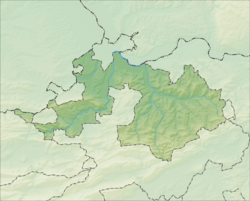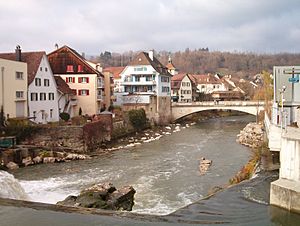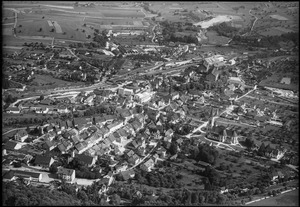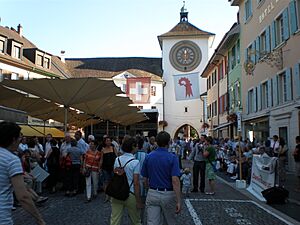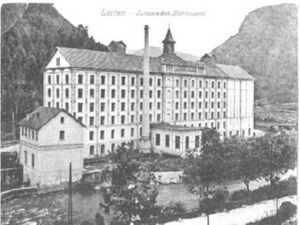Laufen, Switzerland facts for kids
Quick facts for kids
Laufen
|
||
|---|---|---|
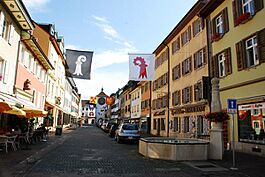 |
||
|
||
| Country | Switzerland | |
| Canton | Basel-Landschaft | |
| District | Laufen | |
| Area | ||
| • Total | 11.4 km2 (4.4 sq mi) | |
| Elevation | 354 m (1,161 ft) | |
| Population
(Jun 2021 )
|
||
| • Total | 5,814 | |
| • Density | 510.0/km2 (1,321/sq mi) | |
| Postal code |
4242
|
|
| Surrounded by | Bärschwil (SO), Brislach, Dittingen, Grindel (SO), Liesberg, Röschenz, Wahlen bei Laufen, Zwingen | |
| Twin towns | Laufen (Germany) | |
Laufen (in French: Laufon) is a town in Switzerland. It is the main town of the Laufen district. It is located in the canton of Basel-Country. Laufen is a municipality with a rich history.
The train station in Laufen is very important. It connects the town to the larger city of Basel.
Contents
History of Laufen
Laufen has a very long history. From 58 BC to 470 AD, it was part of the powerful Roman Empire. After the Roman Empire ended, the area became part of the Alemanish region.
In the early 500s, the entire valley became part of France. Later, from 853 to 1033, it was part of the Burgundian Kingdom. In 999, King Rudolf III of Burgundy gave most of the Laufen valley to the Archbishopric of Basel.
Laufen was first mentioned in records in 1141. At one time, it was also known by its French name, Laufon. The small town of Laufen was officially founded in 1295 by a person named Peter Reich von Reichenstein.
Geography of Laufen
Laufen covers an area of about 11.37 square kilometers (4.39 square miles). A large part of this land is covered by forests, about 52.8%. About 27.0% of the land is used for farming. Around 18.9% of the area has buildings or roads.
The town is located by the Birs river. The old part of Laufen is inside city walls. There are also newer settlements outside the walls. These settlements grew on both sides of the Birs river. The old city and the area outside the walls joined together in 1852.
Laufen's Coat of Arms
The coat of arms for Laufen is simple but meaningful. It shows a silver crozier on a black background. A crozier is a special staff carried by bishops.
People and Population
Laufen has a population of about 5,172 people. Many different languages are spoken here. Most people (about 82.8%) speak German. Italian language is the second most common language, followed by Spanish.
In 2010, about 6.4% of the population were young children. About 14.2% were teenagers between 7 and 19 years old. The largest group of people were adults between 50 and 64 years old.
The historical population of Laufen has changed over time, as shown in this chart:

Important Heritage Sites
Laufen has some important historical places. The Christian-Catholic Church of St. Katharina is a very important building. It is listed as a Swiss heritage site of national significance.
The entire old part of Laufen is also a protected area. It is part of the Inventory of Swiss Heritage Sites. This means its historical buildings and layout are preserved.
Economy and Jobs
Laufen has a busy economy with many jobs. In 2005, about 35 people worked in farming. A much larger number, 966 people, worked in manufacturing and construction. The biggest group, 2,134 people, worked in the service sector. This includes jobs in shops, offices, and healthcare.
Many people travel to Laufen for work. About 1.9 workers come into Laufen for every one person who leaves. Many people use public transportation to get to work. Others use their own cars.
Laufen is home to some well-known companies. These include Ricola, which makes herbal candies. Laufen Bathrooms AG, a company that makes bathroom products, also has its main office here.
Religion in Laufen
In 2000, most people in Laufen were Roman Catholic (about 63.0%). About 14.2% belonged to the Swiss Reformed Church. There were also smaller groups of people who belonged to other Christian churches. Some people were Muslim, Hindu, or Buddhist. A number of people did not belong to any church.
Weather in Laufen
Laufen gets rain or snow for about 139 days each year. On average, it receives about 1021 millimeters (40 inches) of precipitation. August is usually the wettest month. It gets about 119 millimeters (4.7 inches) of rain or snow. February is the driest month. It receives about 66 millimeters (2.6 inches) of precipitation.
Education in Laufen
Many people in Laufen have a good education. About 33.9% of the population have finished high school. About 11.2% have gone on to get a higher education. This means they have studied at a university or a specialized college.
In 2000, many students from other towns came to Laufen for school. Also, some students from Laufen went to schools outside the town.
Notable People from Laufen
- David Pflugi (born 1969 near Laufen), an artist famous for his "Victory Works" for the FIFA football world cup.
- Sehid Sinani (born 1982 in Laufen), a Swiss football player who plays as a defender.
See also
 In Spanish: Laufen para niños
In Spanish: Laufen para niños




